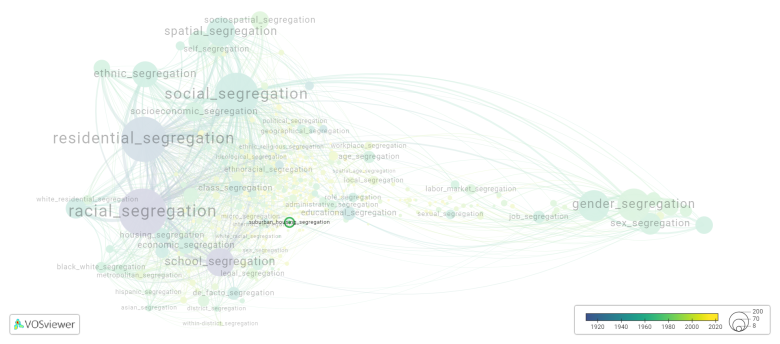Suburban housing segregation: Difference between revisions
(Creating page) |
(Creating page) |
||
| (11 intermediate revisions by the same user not shown) | |||
| Line 1: | Line 1: | ||
===== Date and country of first publication<ref>Date and country of first publication as informed by the Scopus database (December 2023).</ref>===== | |||
1984<br> | 1984<br> | ||
United States | |||
===== Definition ===== | |||
Suburban housing segregation refers to the systemic separation of people of different races or socioeconomic backgrounds within suburban communities. This segregation is often achieved through discriminatory practices such as redlining, restrictive covenants, and exclusionary zoning laws. | Suburban housing segregation refers to the systemic separation of people of different races or socioeconomic backgrounds within suburban communities. This segregation is often achieved through discriminatory practices such as redlining, restrictive covenants, and exclusionary zoning laws. | ||
| Line 19: | Line 18: | ||
Efforts to address suburban housing segregation include fair housing laws, initiatives to promote affordable housing, and attempts to dismantle discriminatory practices within housing markets. However, despite some progress, suburban housing segregation remains a persistent issue that requires ongoing advocacy and policy intervention to achieve equitable and inclusive communities. | Efforts to address suburban housing segregation include fair housing laws, initiatives to promote affordable housing, and attempts to dismantle discriminatory practices within housing markets. However, despite some progress, suburban housing segregation remains a persistent issue that requires ongoing advocacy and policy intervention to achieve equitable and inclusive communities. | ||
==See also== | ==See also== | ||
==Related segregation forms== | |||
Suburban housing segregation is frequently discussed in the literature with the following segregation forms: | |||
[[housing segregation]] | |||
[[File:suburban_housing_segregation.png|780x780px]] | |||
This visualization is based on the study [[Segregation_Wiki:About| The Multidisciplinary Landscape of Segregation Research]]. | |||
For the complete network of interrelated segregation forms, please refer to: | |||
* [https://tinyurl.com/2235lkhw First year of publication] | |||
* [https://tinyurl.com/2d8wg5n3 Louvain clusters] | |||
* [https://tinyurl.com/223udk5r Betweenness centrality] | |||
* [https://tinyurl.com/244d8unz Disciplines in which segregation forms first emerged (Scopus database).] | |||
==References== | ==References== | ||
==Notes== | ==Notes== | ||
<references /> | <references /> | ||
== | {{NoteAI}} | ||
==Suburban housing segregation appears in the following literature== | |||
Gottlieb H.N. (1984) | Gottlieb H.N. (1984). The school effects of Chicago suburban housing segregation. ''Equity and Excellence in Education'', ''21''(1-6), 105-109. https://doi.org/10.1080/0020486840210106 | ||
Lamb C.M. (2005) | Lamb C.M. (2005). Housing segregation in Suburban America since 1960: Presidential and judicial politics. ''Housing Segregation in Suburban America since 1960: Presidential and Judicial Politics'', 1-302. Cambridge University Press.https://doi.org/10.1017/CBO9780511614354 | ||
Latest revision as of 07:17, 16 October 2024
Date and country of first publication[1][edit | edit source]
1984
United States
Definition[edit | edit source]
Suburban housing segregation refers to the systemic separation of people of different races or socioeconomic backgrounds within suburban communities. This segregation is often achieved through discriminatory practices such as redlining, restrictive covenants, and exclusionary zoning laws.
Historically, suburban development in many countries, particularly the United States, was characterized by intentional efforts to create homogenous communities. These efforts aimed to maintain racial and socioeconomic exclusivity, effectively excluding marginalized groups from accessing suburban housing opportunities.
Redlining was a practice where banks and lending institutions drew boundaries around neighborhoods, designating them as high-risk areas for investment based on racial criteria. This made it difficult for people of color to obtain loans or mortgages, thereby limiting their housing options and perpetuating segregation.
Restrictive covenants were legally binding agreements that prohibited homeowners from selling their property to individuals of certain racial or ethnic backgrounds. These covenants were widely used in the 20th century and had the effect of excluding minority groups from suburban communities.
Exclusionary zoning laws were implemented to keep certain groups out of affluent suburbs. These laws often required large lot sizes, high property values, or specific architectural styles that effectively prevented low-income individuals from residing in these areas.
The consequences of suburban housing segregation are wide-ranging and can perpetuate racial and socioeconomic disparities. Segregated communities often lack access to quality education, healthcare, and other resources. Research has shown that segregated neighborhoods contribute to the perpetuation of economic inequality and limit upward mobility for marginalized groups.
Efforts to address suburban housing segregation include fair housing laws, initiatives to promote affordable housing, and attempts to dismantle discriminatory practices within housing markets. However, despite some progress, suburban housing segregation remains a persistent issue that requires ongoing advocacy and policy intervention to achieve equitable and inclusive communities.
See also[edit | edit source]
Related segregation forms[edit | edit source]
Suburban housing segregation is frequently discussed in the literature with the following segregation forms:
This visualization is based on the study The Multidisciplinary Landscape of Segregation Research.
For the complete network of interrelated segregation forms, please refer to:
References[edit | edit source]
Notes[edit | edit source]
- ↑ Date and country of first publication as informed by the Scopus database (December 2023).
At its current state, this definition has been generated by a Large Language Model (LLM) so far without review by an independent researcher or a member of the curating team of segregation experts that keep the Segregation Wiki online. While we strive for accuracy, we cannot guarantee its reliability, completeness and timeliness. Please use this content with caution and verify information as needed. Also, feel free to improve on the definition as you see fit, including the use of references and other informational resources. We value your input in enhancing the quality and accuracy of the definitions of segregation forms collectively offered in the Segregation Wiki ©.
Suburban housing segregation appears in the following literature[edit | edit source]
Gottlieb H.N. (1984). The school effects of Chicago suburban housing segregation. Equity and Excellence in Education, 21(1-6), 105-109. https://doi.org/10.1080/0020486840210106
Lamb C.M. (2005). Housing segregation in Suburban America since 1960: Presidential and judicial politics. Housing Segregation in Suburban America since 1960: Presidential and Judicial Politics, 1-302. Cambridge University Press.https://doi.org/10.1017/CBO9780511614354

